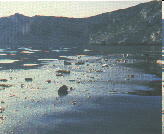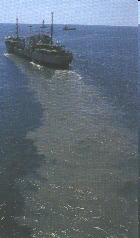Refuse closer to shore
scattered bits of rubbish alongside a few sea-urchins and patches
of remaining seaweed. The almost
Detergents
contained in waste water discharged into the sea have attacked the under water
plants
underwater prairies, the marine pastureland, that once prospered in this region
has died away completely.
like
herbicide.
Chemical
analysis of the water reveals the presence of many toxic (poisonous) substances
(mercury,
sea-water to extract plankton as food can become poisonous for the people who
eat them.
Tar
on the beaches and in the sea
The
tar comes from ships, particularly from oil-tankers that wash out their holds
at sea. The oil spreads out as a very thin layer on the water surface, cutting
out some of the light, destroying plankton and poisoning animals. When the oil
layer evaporates, it leaves behind heavy residues which are either washed up
along thecoast or deposited on the sea-bed.
lead, arsenic etc) along with a thriving population of germs. As a result, animals
such as oysters that filter
Closer
to the shore, a carpet of floating refuse can be seen. A diver would find on
the sea-bed

